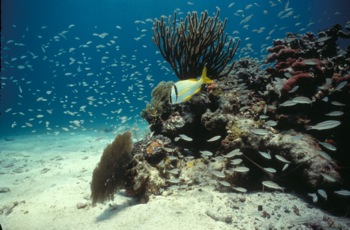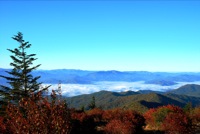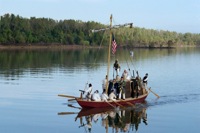
Through the mist and trees of Great Smoky Mountains National Park, you can almost see the very soul of the Southeast. Across the ridges of unspoiled forest, the essence of this region seems to emanate from nature itself.
The mountains, forests, marshes and seashores of the Southeast have played an instrumental role in the development of its culture and character. At Great Smoky Mountains and other national parks throughout the region, visitors can see and experience some of the area’s most treasured sites.
Since they were first established in the 1870s, national parks have preserved the most scenic and important places across the country. From Florida to Arkansas and North Carolina, areas protected by the National Park System include ecologically rich marshlands, beautiful forests and historic outposts, among many others. To get a deeper sense of what this land is all about, consider a visit to one of these national park sites on your next tour through the Southeast.
Great Smoky Mountains National Park
Tennessee/North Carolina
Among the parks of the Southeast, Great Smoky Mountains National Park claims a number of superlatives, including the title of most-visited national park in the country.
 “The major attraction here is the scenery,” said Bob Miller, public affairs officer at the park. “The Smokies offer the largest and broadest swath of undeveloped scenery in the Southeast. We have 16 peaks over 1,600 feet in height, and from most areas you see ridge on ridge of undeveloped forest in every direction.”
“The major attraction here is the scenery,” said Bob Miller, public affairs officer at the park. “The Smokies offer the largest and broadest swath of undeveloped scenery in the Southeast. We have 16 peaks over 1,600 feet in height, and from most areas you see ridge on ridge of undeveloped forest in every direction.”
The most popular activity for groups in the park is to take a scenic drive along one of several byways. A 32-mile road from Gatlinburg, Tennessee, to Cherokee, North Carolina, is known for its many stopping points and scenic overlooks. Another 27-mile road takes visitors from the Sugarlands entrance along the river valley to Cade’s Cove, a community of preserved farms, churches and a working gristmill that dates back to around 1900.
The park is also one of the most biologically diverse in the temperate areas of the United States. More than 100,000 species of plants and animals live there, including 60 species of mammals, 200 species of birds and 135 tree species. Visitors often see all kinds of wildlife during their time in the park, including ever-popular black bears.
“The park has about 1,600 bears, about two per square mile,” Miller said. “The chances of seeing a bear in the summer are pretty high. You see bears, deer and wild turkey in abundance in their natural setting.”
Cape Hatteras National Seashore
North Carolina
The area known collectively as Cape Hatteras National Seashore comprises three national park sites, including the shore, the Wright Brothers National Monument and Fort Raleigh National Historic Site.
 The seashore itself consists of about 69 miles of beach inhabited by a wealth of wildlife.
The seashore itself consists of about 69 miles of beach inhabited by a wealth of wildlife.
“It’s a coastal environment where wind and water pretty much rule,” said public information officer Cindy Holda. “There’s great shelling, great hiking and beachcombing. The sound side is an estuary environment where you can go crabbing. We have beautiful sunsets and gorgeous sunrises.”
Many groups enjoy visiting the three historic lighthouses at the national seashore. On Hatteras Island, the 1870 lighthouse stands 250 feet tall and is painted with black and white stripes. The much smaller Ocracoke Light Station sits on Ocracoke Island, a relaxing place accessible only by ferryboat.
The Wright Brothers National Monument commemorates the spot where the first manned flight took place on the beach at Kitty Hawk. Visitors to the monument learn about the Wrights and see panoramic vistas of the Outer Banks.
Fort Raleigh preserves an intriguing historic site.
“It’s the settlement where the first English colonists attempted to begin life in this country,” Holda said. “It was not successful, and they were called the Lost Colony.”
Today, the historic site includes a small restored fortification with evidence of the 1586 settlement.
www.nps.gov/caha
Fort Smith National Historic Site
Arkansas
Located on the Arkansas River just across the border from Oklahoma, Fort Smith National Historic Site preserves the place where federal soldiers and marshals were sent to keep peace in the Old West.
 “The fort was founded in 1817,” said superintendent Bill Black. “The military came out here to try to prevent warfare between the Osage Indians and the Cherokees, who were voluntarily leaving the Southeast and moving into this part of the country.”
“The fort was founded in 1817,” said superintendent Bill Black. “The military came out here to try to prevent warfare between the Osage Indians and the Cherokees, who were voluntarily leaving the Southeast and moving into this part of the country.”
Later, when the government forcibly removed five tribes from the East, the Trail of Tears passed through Fort Smith. During the Civil War, the fortress was occupied by both Union and Confederate forces at different times.
It was after the Civil War that Fort Smith became famous as the home base of the U.S. marshals.
“The federal court for the western district of Arkansas had control of almost all of the Indian Territory,” Black said. “The federal marshals rode out of Fort Smith to provide law and order all over the territory.”
Today, visitors to the site can see remnants of the original fortress and visit the courtroom of the famous “hanging judge,” Isaac Parker. Restored gallows outside the courthouse mark the spot where executions took place.
www.nps.gov/fosm
Congaree National Park
South Carolina
Some 24,000 acres of hardwood forest make up Congaree National Park, a place where trees grow to prized proportions.
 “Congaree is an old-growth floodplain forest, which has 25 champion trees,” said the park’s Stuart Greeter. “If you want to see the way the forest once was, this is the place to come.”
“Congaree is an old-growth floodplain forest, which has 25 champion trees,” said the park’s Stuart Greeter. “If you want to see the way the forest once was, this is the place to come.”
The term “champion trees” refers to a method of scoring trees according to their size and other characteristics. A champion tree scores the highest in its region; Congaree is home to six national champion trees and 19 South Carolina champions.
Visitors have a variety of options for exploring the floodplains and forest. On weekends, rangers lead free canoe tours along Cedar Creek, an area surrounded by bald cypress and water tupelo trees draped with spanish moss. Participants often see white-tailed deer, otters, songbirds and woodpeckers along the way.
A number of guided tours are available throughout the week as well. On Friday nights, groups that make reservations can join an Owl Prowl, which highlights the nocturnal creatures during the times that they are active.
Biscayne National Park
Florida
A fascinating world of marine life is on display at Biscayne National Park, not far from Miami.
“Biscayne National Park is the largest marine park in the national park system,” said chief of interpretation Susan Gonshor. “It protects the longest stretch of unbroken mangrove shoreline in southeast Florida. It’s the northern portion of the world’s largest coral reef, about 40 islands and two-thirds of Biscayne Bay.”
The bay is full of wildlife, including sea turtles, dolphins, manatees, crocodiles and numerous species of birds and fish. Adventurous travelers can spend time snorkeling, swimming or diving in the bay, where the water averages only 8 feet deep.
A number of options make it easy for groups to explore the bay. A concessionaire in the park operates a boat tour and ferry service that shuttles visitors between the mainland and some of the islands in the park. Visitors can also take guided canoeing and kayaking trips.
“You can basically see Miami from our visitors center; but when you’re out on the water, you’re really a world away,” Gonshor said. “It’s very uncrowded down here. It’s a great way to see what unpopulated parts of Florida are like without going all the way down to the Keys.”









